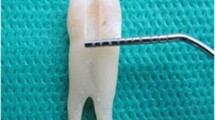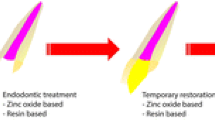Abstract
Reducing treatment time is one of the most important trends in modern dentistry. This study aimed to compare the micro-leakage around the resin sealants when using both high and conventional intensity light-curing systems. The study sample consisted of 30 extracted human maxillary premolar teeth that were divided into two equal groups according to the light-curing system used: Group 1, High-Intensity Light-Curing System and Group 2, Conventional Light-Curing System. Light-curing by Woodpecker I-LED device with two intensities (high and conventional) has been used. All teeth were subjected to 500 cycles of thermocycling. Then, a methylene blue dye microleakage test was performed, and the teeth were sectioned longitudinally and studied under a stereo microscope. The mean of micro-leakage in the high-intensity group (1.33 ± 1.29) was less than in the conventional intensity group (1.63 ± 1.29) without any statistically significant differences (p = 0.320). The high-intensity light-curing system mode may be a good and acceptable alternative to conventional intensity light-curing system mode in polymerization of pits and fissure sealants.



Similar content being viewed by others
Data availability
The data that support the findings of this study are available from the corresponding author.
References
Strużycka I (2014) The oral microbiome in dental caries. Pol J Microbiol 63(2):127. https://doi.org/10.33073/pjm-2014-018
Ahovuo-Saloranta A et al (2017) Pit and fissure sealants for preventing dental decay in permanent teeth. Cochrane Database Syst Rev 7. https://doi.org/10.1111/eos.12758
Hiiri A et al (2010) Pit and fissure sealants versus fluoride varnishes for preventing dental decay in children and adolescents. Cochrane Database Syst Rev 3. https://doi.org/10.1002/14651858.CD003067.pub3
Zeng Z et al (2013) Genome-wide association studies of pit-and-fissure-and smooth-surface caries in permanent dentition. J Dent Res 92(5):432–437. https://doi.org/10.1177/00220345134819
Zeng Z et al (2014) Genome-wide association study of primary dentition pit-and-fissure and smooth surface caries. Caries Res 48(4):330–338. https://doi.org/10.1159/000356299
Beiruti N et al (2006) Caries-preventive effect of resin-based and glass ionomer sealants over time: a systematic review. Community Dent Oral Epidemiol 34(6):403–409. https://doi.org/10.1111/j.1600-0528.2006.00321.x
Shimokawa CAK et al (2020) Effect of curing light and exposure time on the polymerization of bulk-fill resin-based composites in molar teeth. Oper Dent 45(3):E141–E155. https://doi.org/10.2341/19-126-L
Malhotra N, Kundabala M (2010) Light-curing considerations for resin-based composite materials: a review. Part I CompendContinEduc Dent 31(7):498–505
Koran P, Kürschner R (2001) Effects of sequential versus continuous irradiation of a light-cured resin composite on shrinkage, viscosity, adhesion, and degree of polymerization. J Esthet Restor Dent 13(2):140–141. https://doi.org/10.1111/j.1708-8240.2001.tb00437.x
Armfield JM, Heaton L (2013) Management of fear and anxiety in the dental clinic: a review. Aust Dent J 58(4):390–407. https://doi.org/10.1111/adj.12118
Cooley RL, McCourt JW (1990) Evaluation of by SEM, microleakage, and fluoride release. Pediatr Dent 12(1):39
Condò R et al (2013) Sealants in dentistry: a systematic review of the literature. Oral and Implantology 6(3):67
Sanders BJ, Feigal RJ, Avery DR (2010) Pit and fissure sealants and preventive resin restorations. Dentistry for the child and adolescent, 9th edn. Mosby, St. Louis, pp 313–321
Srinivasan V, Deery C, Nugent Z (2005) In-vitro microleakage of repaired fissure sealants: a randomized, controlled trial. Int J Paediatr Dent 15(1):51–60. https://doi.org/10.1111/j.1365-263x.2005.00609.x
Hadole PG, Daokar SS (2019) Light-curing unit (devices). Int J Orthod Rehabil 10(3):121. https://doi.org/10.4103/ijor.ijor_1_19
Townsend JA, Wells MH (2019) Behavior guidance of the pediatric dental patient, in Pediatric dentistry. Elsevier, pp 352–370.e2
Pérez-Lajarín L et al (2003) Marginal microleakage of two fissure sealants: a comparative study. J Dent Child 70(1):24–28
Burrow M, Makinson O (1990) Pits and fissures: remnant organic debris after acid-etching. ASDC J Dent Child 57(5):348–351
Hannig M et al (2004) Microleakage and SEM evaluation of fissure sealants placed by use of self-etching priming agents. J Dent 32(1):75–81. https://doi.org/10.1016/j.jdent.2003.08.005
Baghalian A et al (2013) Microleakage of Er: YAG laser and dental bur prepared cavities in primary teeth restored with different adhesive restorative materials. Lasers Med Sci 28(6):1453–1460. https://doi.org/10.1007/s10103-012-1222-0
Mithiborwala S et al (2012) A comparison of the resin tag penetration of the total etch and the self-etch dentin bonding systems in the primary teeth: an in vitro study. Contemp Clin Dent 3(2):158. https://doi.org/10.4103/0976-237x.96818
Kitasako Y et al (2000) The influence of storage solution on dentin bond durability of resin cement. Dent Mater 16(1):1–6. https://doi.org/10.1016/s0109-5641(99)00061-5
Titley K et al (1998) The effect of various storage methods and media on shear-bond strengths of dental composite resin to bovine dentine. Arch Oral Biol 43(4):305–311. https://doi.org/10.1016/s0003-9969(97)00112-x
McCabe JF, Walls AW (2013) Applied dental materials. John Wiley & Sons
Penugonda B et al (1992) Bonding Ni-Cr alloy to tooth structure with adhesive resin cements. J Esthet Restor Dent 4:26–29
Styner D et al (1992) Bonding composite to glass lonomer with adhesive resin cements. J Esthet Restor Dent 4:13–15
Pardi V et al (2006) In vitro evaluation of microleakage of different materials used as pit-and-fissure sealants. Braz Dent J 17:49–52. https://doi.org/10.1590/s0103-64402006000100011
Jacobs MS, Windeler AS (1991) An investigation of dental luting cement solubility as a function of the marginal gap. J Prosthet Dent 65(3):436–442. https://doi.org/10.1016/0022-3913(91)90239-s
Baldissara P et al (1998) Comparative study of the marginal microleakage of six cements in fixed provisional crowns. J Prosthet Dent 80(4):417–422. https://doi.org/10.1016/s0022-3913(98)70005-8
Gp H, JOSEPH T, JAYANTHI M (2004) Comparative evaluation of glass lonomer and resin based fissure sealant using noninvasive and invasive techniques-A SEM and microleakage study. J Indian Soc Pedo Prey Dent 22(2):56–62
Kwon HB, Park KT (2006) SEM and microleakage evaluation of 3 flowable composites as sealants without using bonding agents. Pediatr Dent 28(1):48–53
Joshi K et al (2013) Comparative evaluation of two different pit & fissure sealants and a restorative material to check their microleakage–an in vitro study. J Int Oral Health 5(4):35
Nurlatifah A, Eriwati Y, Indrani D (2018) The effect of the curing time of an ultra-high intensity LED curing unit on diametral tensile strength of packable composite resin. In: Journal of Physics: Conference Series. IOP Publishing
Price RB (2017) Light curing in dentistry. Dental Clinics 61(4):751–778
Sridhar LP et al (2016) Comparative evaluation of the marginal sealing ability of two commercially available pit and fissure sealants. J Clin Diagn Res 10(9):ZC01. https://doi.org/10.7860/JCDR/2016/19996.8413
Bayrak G-D et al (2020) Assessment of shear bond strength and microleakage of fissure sealant following enamel deproteinization: an in vitro study. J Clin Exp Dent 12(3):e220. https://doi.org/10.4317/jced.56281
Bahrololoomi Z, Soleymani A, Heydari Z (2011) In vitro comparison of microleakage of two materials used as pit and fissure sealants. J Dent Res Dent Clin Dent Prospects 5(3):83. https://doi.org/10.5681/joddd.2011.019
Author information
Authors and Affiliations
Contributions
RM and AH conceived the idea and provided the treatment. AH contributed to the writing and documenting. BN and ABM conceived the idea and supervised the treatment.
Corresponding author
Ethics declarations
Conflict of interest
The authors declare no competing interests.
Additional information
Publisher’s note
Springer Nature remains neutral with regard to jurisdictional claims in published maps and institutional affiliations.
Rights and permissions
Springer Nature or its licensor (e.g. a society or other partner) holds exclusive rights to this article under a publishing agreement with the author(s) or other rightsholder(s); author self-archiving of the accepted manuscript version of this article is solely governed by the terms of such publishing agreement and applicable law.
About this article
Cite this article
Alzoubi, H., Rajab, M., Bshara, N. et al. Evaluation of the effect of high-intensity light-curing device on micro-leakage of pits and fissure sealants. Lasers Med Sci 39, 19 (2024). https://doi.org/10.1007/s10103-023-03963-3
Received:
Accepted:
Published:
DOI: https://doi.org/10.1007/s10103-023-03963-3




